When To Repot Orchids: Key Signs To Look For
Learn the signs that indicate it's time to repot your orchids and discover expert tips to ensure your plants thrive and bloom beautifully.
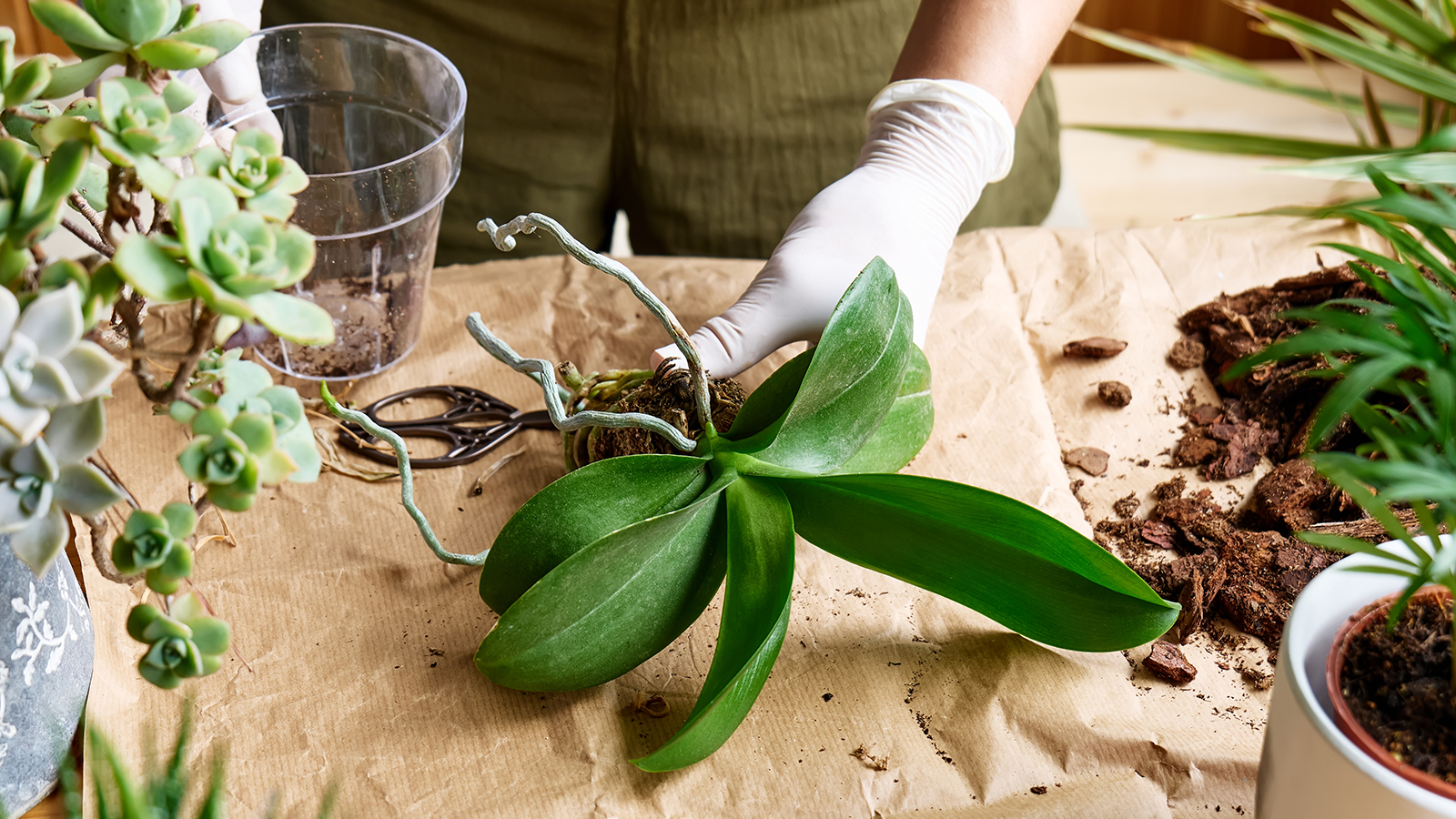

Melanie Griffiths
Orchids are one of the largest families of flowering plants, with thousands of species found across the globe in every continent except Antarctica. The plants have a reputation as being hard to grow, but looking after them is easier than you might think.
Knowing when to repot orchids is key to helping these exotic beauties to thrive. Over time the potting medium breaks down and compacts, and the plants deplete the available nutrients. Repotting orchids will refresh the soil and give plants the boost they need for new growth.
A vital aspect of orchid care, repotting can make all the difference in transforming the plant's health and is often the first port of call if you want to revive a struggling orchid or encourage repeat blooms.
As there are so many different types of orchids, you must follow the care requirements for your particular variety. For example, the best orchid potting medium may include more absorbent materials for species that don't like to dry out, or it may be a drier bark mix for pseudobulb orchids that retain more water within the plant.
Choosing the right orchid container is also key. Clear plastic pots with drainage holes are best, as they allow you to inspect the health of the orchid roots.
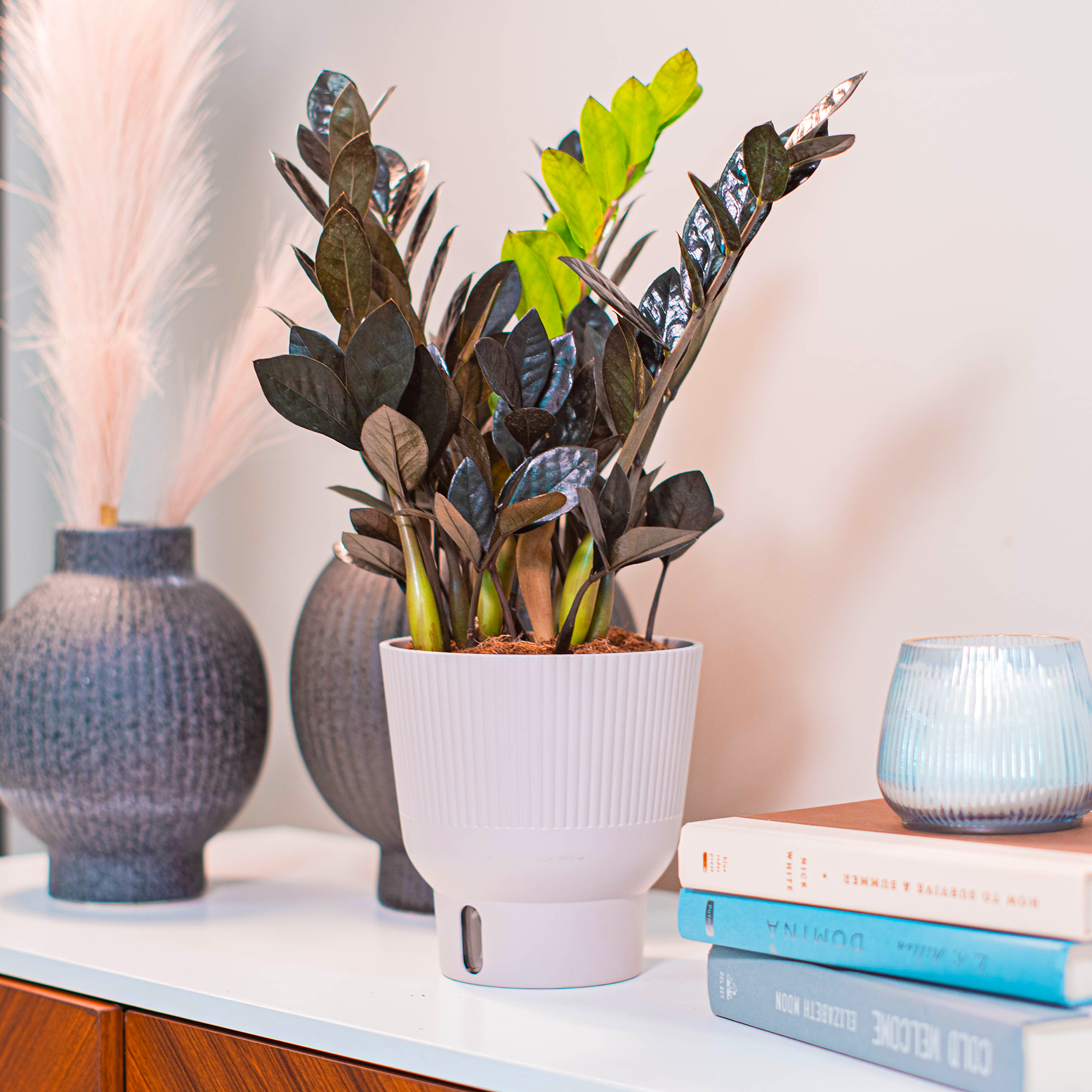
Costa Farms searches the globe seeking out the most beautiful and unusual houseplants that thrive in home interiors – supplied in self-watering pots.
When To Repot An Orchid
Most orchid species need to be repotted around every two years. However, rather than do it on a schedule, it's best to monitor the plant for signs it's ready to be transplanted.
Choose the time of year that's best for the plant. If you have a cattelya or other orchid that produces pseudobulbs, repot it right after flowering and before the roots begin to grow.
Gardening tips, videos, info and more delivered right to your inbox!
Sign up for the Gardening Know How newsletter today and receive a free copy of our e-book "How to Grow Delicious Tomatoes".
For most other orchids, the best time to repot an orchid is when it is not actively growing, after it has bloomed in the spring or summer. You can also repot the plant when you see new growth in the winter or early spring.
Unless there is an urgent need to repot, such as in the case of disease or insects, wait until the blooms are done.
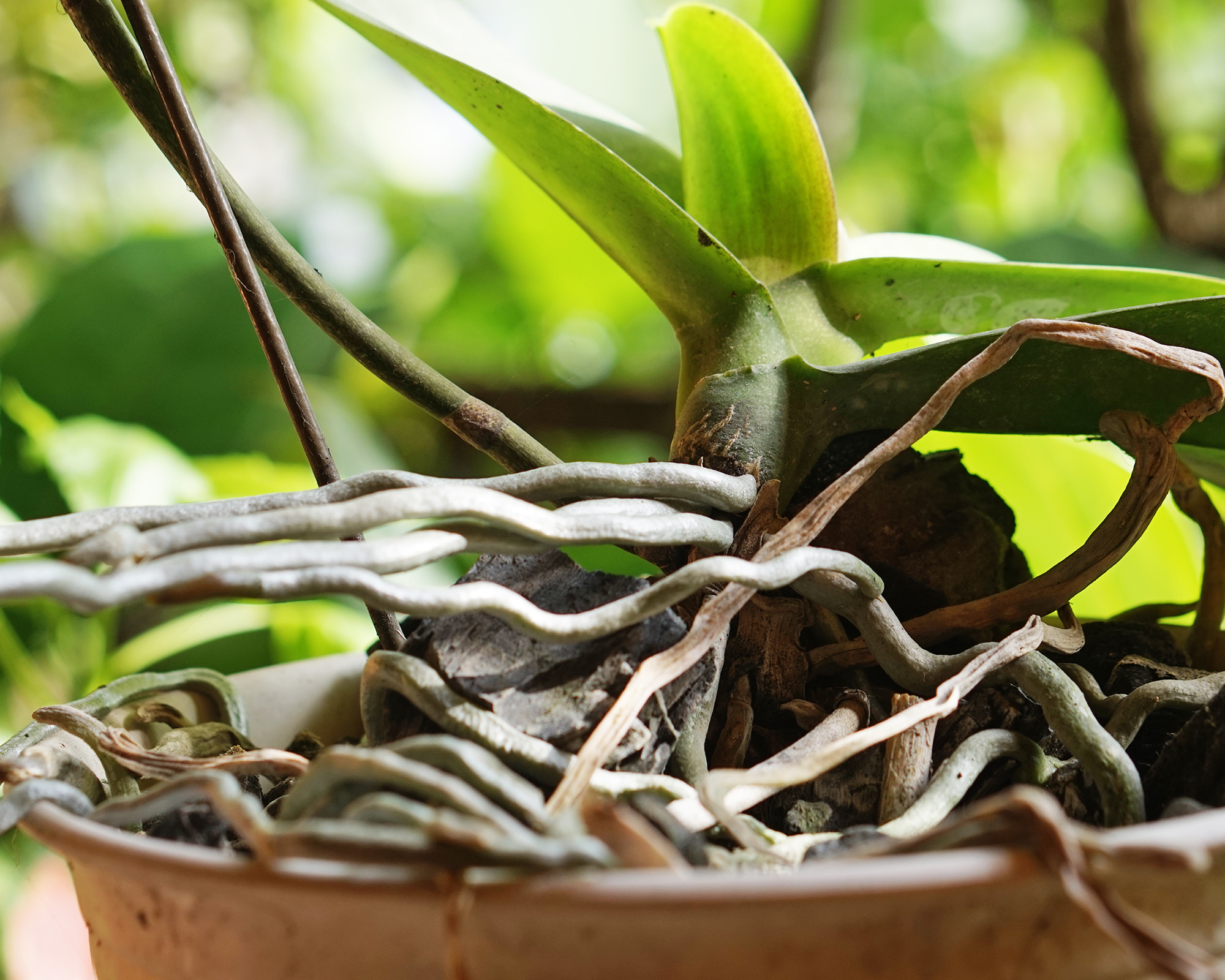
Signs It’s Time To Repot Your Orchid
- When the aerial roots are prolific or the soil-borne roots take over the pot. In these cases the roots cannot get enough moisture and keeping the plant hydrated becomes difficult. If watering orchids has become a daily endeavor, it is time to repot the plant.
- When the medium has broken down or is moldy or otherwise compromised. After a couple of years, the bark and other material will get stinky, rotten, and crumble easily in your fingers.
- When the plant is affected by a fungal disease or orchid pests. Overly wet and old material can produce mushrooms or other fungal bodies. Mealybugs and other insects often infest the potting medium.
- When your plant’s container is unsuitable. This could either be that the container is too small or large, or it could be too porous or too sealed. Whether natural evaporation is necessary or the variety needs to be kept damp, the container needs to be suitable for those conditions. An unglazed clay pot will dry out more quickly, while a glazed ceramic pot will hold water.
- When dead roots are present. This is a cue to remove the pot from the old medium and do some judicious pruning to remove any dead or diseased roots and freshen the medium.
- As the orchid mix breaks down, the pieces get tinier and tinier, compacting the soil and reducing the oxygen that can get into it. As the medium gets finer it holds more soil which can be bad for most orchid roots. Root rot and other fungal diseases often occur in such conditions.
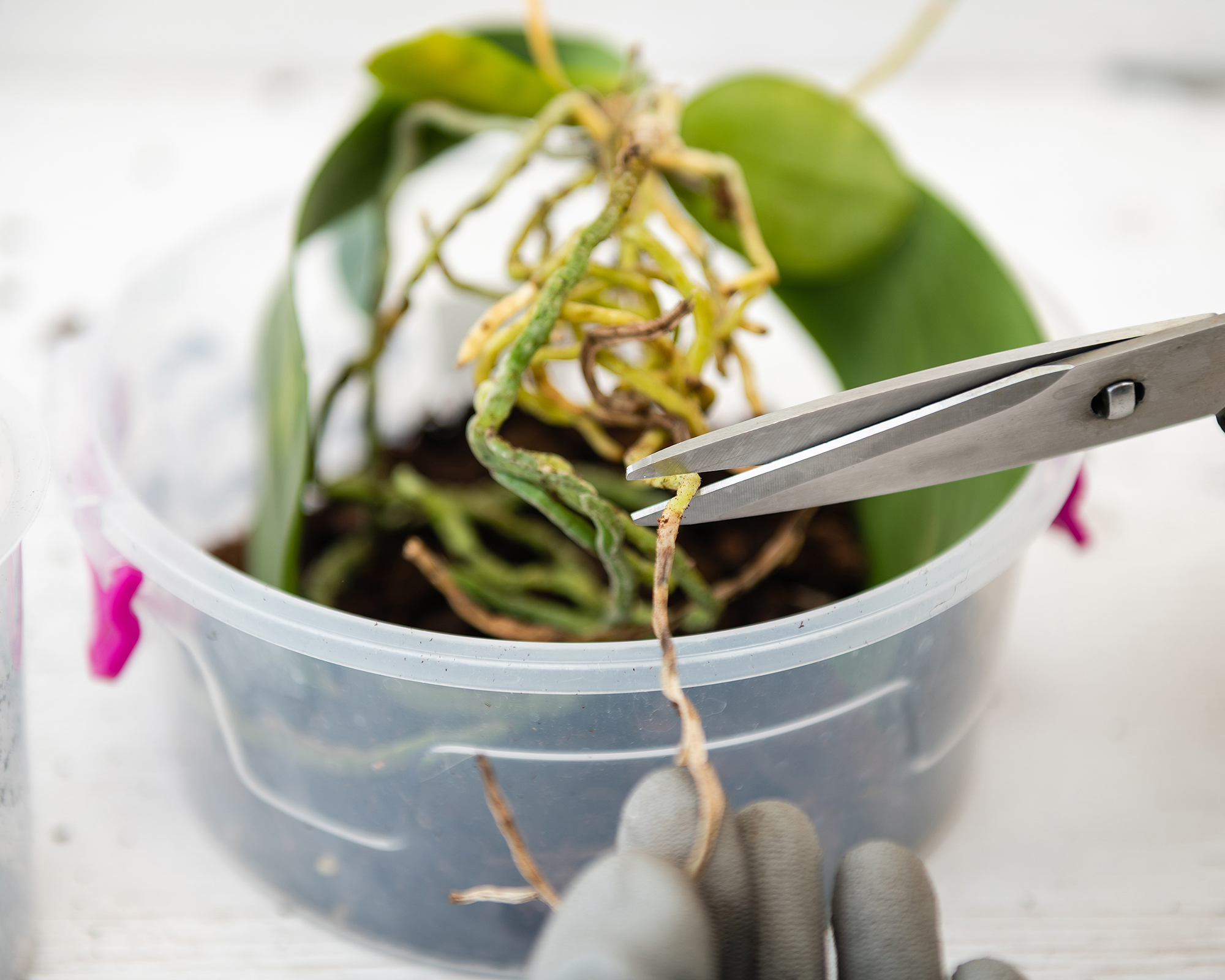
Tips For Repotting Orchids
Before repotting your orchid, prune the old flower stem at the bottom node. Remove any stakes and clips. For newer flowering spikes, cut 1 inch (2.5cm) above the top node.
Remove the plant from its container and shake off the old media. Inspect the roots. Using sterile snips or pruners, cut out any diseased, soft, or discolored roots. Orchid roots should be evenly colored and firm.
Some orchid experts recommend sprinkling cinnamon on the roots after trimming to prevent fungal diseases.
Select a container that is 1-2 inches (2.5-5cm) larger than the previous pot. Repot and backfill around the roots with fresh media. Water and care for the plant as usual.
About Orchid Pots
The size of the pot depends upon the size of the plant. For most orchids, choose a container with a top diameter that is a third of the height of the orchid plant itself.
You can purchase those pretty, almost doily patterned ceramic pots that have decorative gaps to increase airflow. You can also select an unglazed, plain terracotta pot. This will be fine for most varieties.
Orchids that need to be kept quite moist will benefit from plastic pots which will keep in moisture. Other orchids will thrive in mesh containers with a liner of sphagnum moss and orchid medium. If in doubt, mimic the container the plant came in, but go up a size at repotting time.
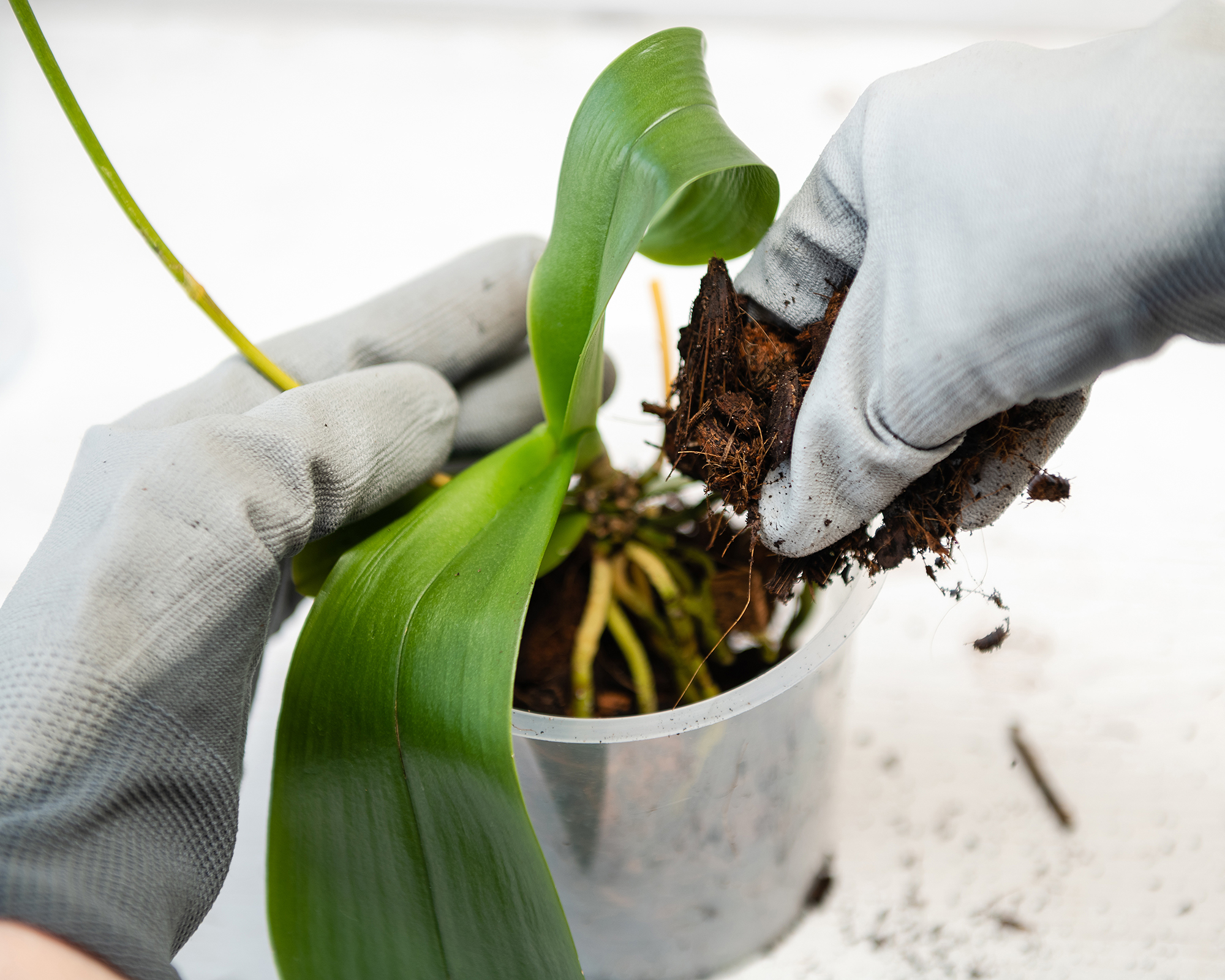
The Right Potting Mix
Many orchids don’t grow in regular terrestrial soil. They will not thrive in gardens or potting soil. Many of these species are epiphytic and grow in tree crotches, rock crevasses, and other mostly soil-less areas. They need a very well-draining medium that lets in air.
Most purchased orchid mixes are made of bark, sphagnum moss, tree fern, and lava rock. Fir and Monterey bark are the most common barks in these mixes. The medium may also have clay pellets added to enhance drainage and prevent compaction.

Bonnie Grant is a professional landscaper with a Certification in Urban Gardening. She has been gardening and writing for 15 years. A former professional chef, she has a passion for edible landscaping.
- Melanie GriffithsSenior Editor
-
 Looking For Plants To Give You The Soft And Fuzzies? Try These 5 Fuzzy Leaf Plant Options
Looking For Plants To Give You The Soft And Fuzzies? Try These 5 Fuzzy Leaf Plant OptionsLovers of texture, drama, silver foliage and tactile plants will adore these special sensory garden additions. These fuzzy leaf plant options will leave you all aglow
By Susan Albert
-
 Get Ready For A Summer Of Hummers! Grow These Full Sun Hummingbird Plants and Flowers
Get Ready For A Summer Of Hummers! Grow These Full Sun Hummingbird Plants and FlowersIf you’re lucky enough to enjoy a sunny backyard, make sure you are maxing out on your pollinator opportunities and grow these full sun hummingbird plants and flowers
By Tonya Barnett
-
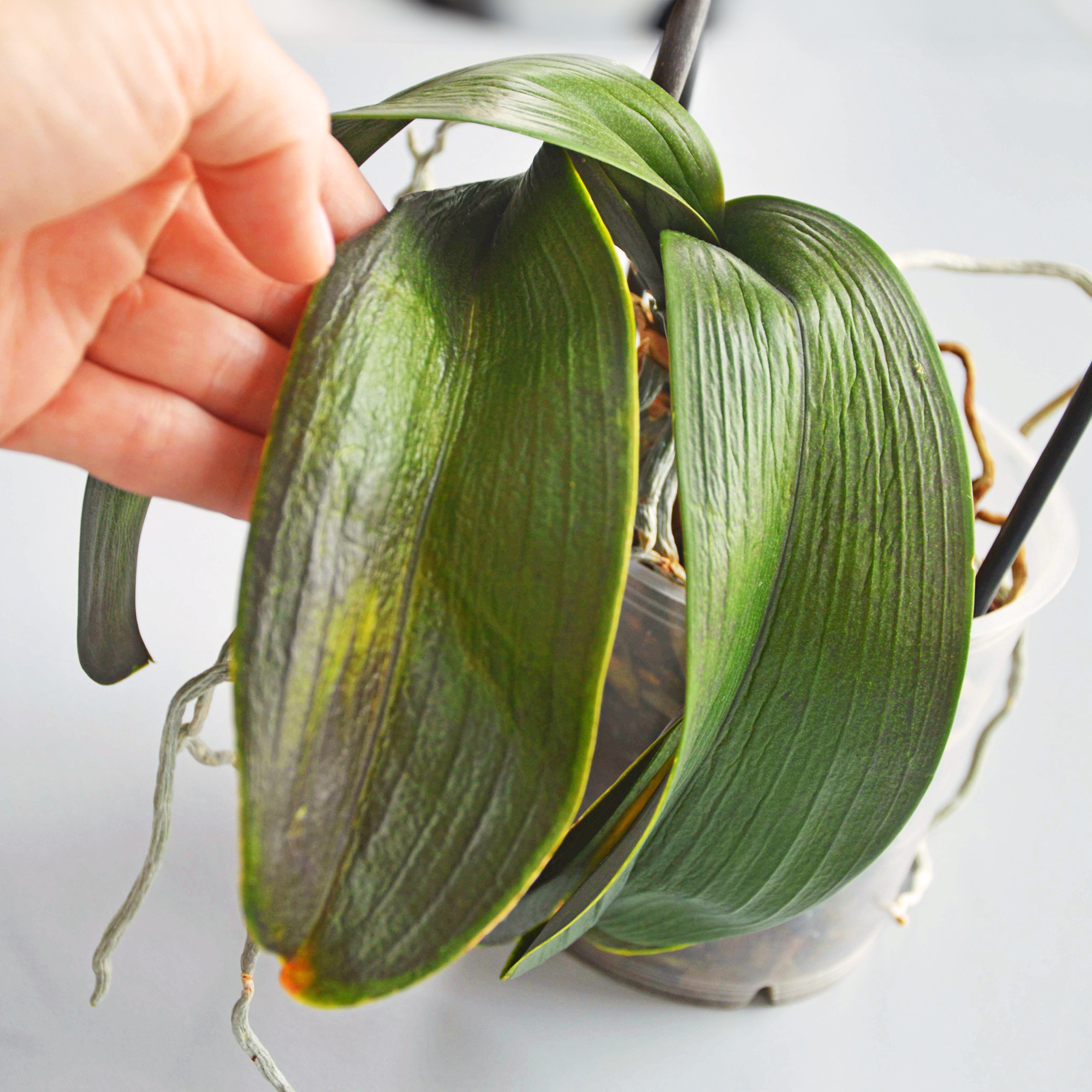 Orchid Leaves Wrinkled? 5 Common Causes & How To Restore Their Vitality
Orchid Leaves Wrinkled? 5 Common Causes & How To Restore Their VitalityAre your beloved orchid's leaves wrinkled? Worry not! Here are the most common causes for puckered orchid foliage, plus how to plump them back up.
By Tonya Barnett
-
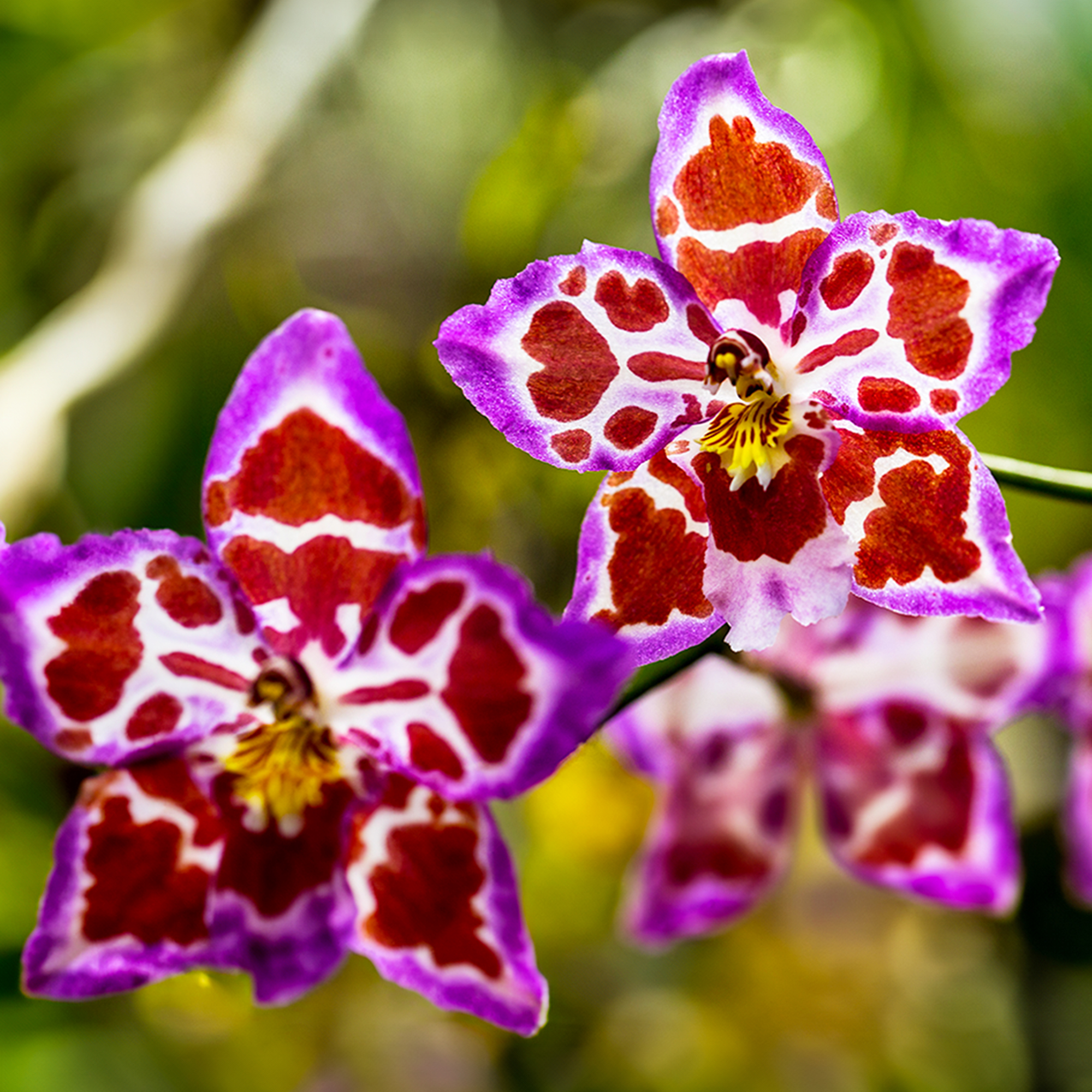 8 Rare Orchids That Make Stunning Houseplants – Some Are Surprisingly Easy To Grow
8 Rare Orchids That Make Stunning Houseplants – Some Are Surprisingly Easy To GrowDiscover unique orchids that will add exotic beauty to your home. Some make easygoing houseplants, while others offer a challenge for more seasoned growers.
By Melanie Griffiths
-
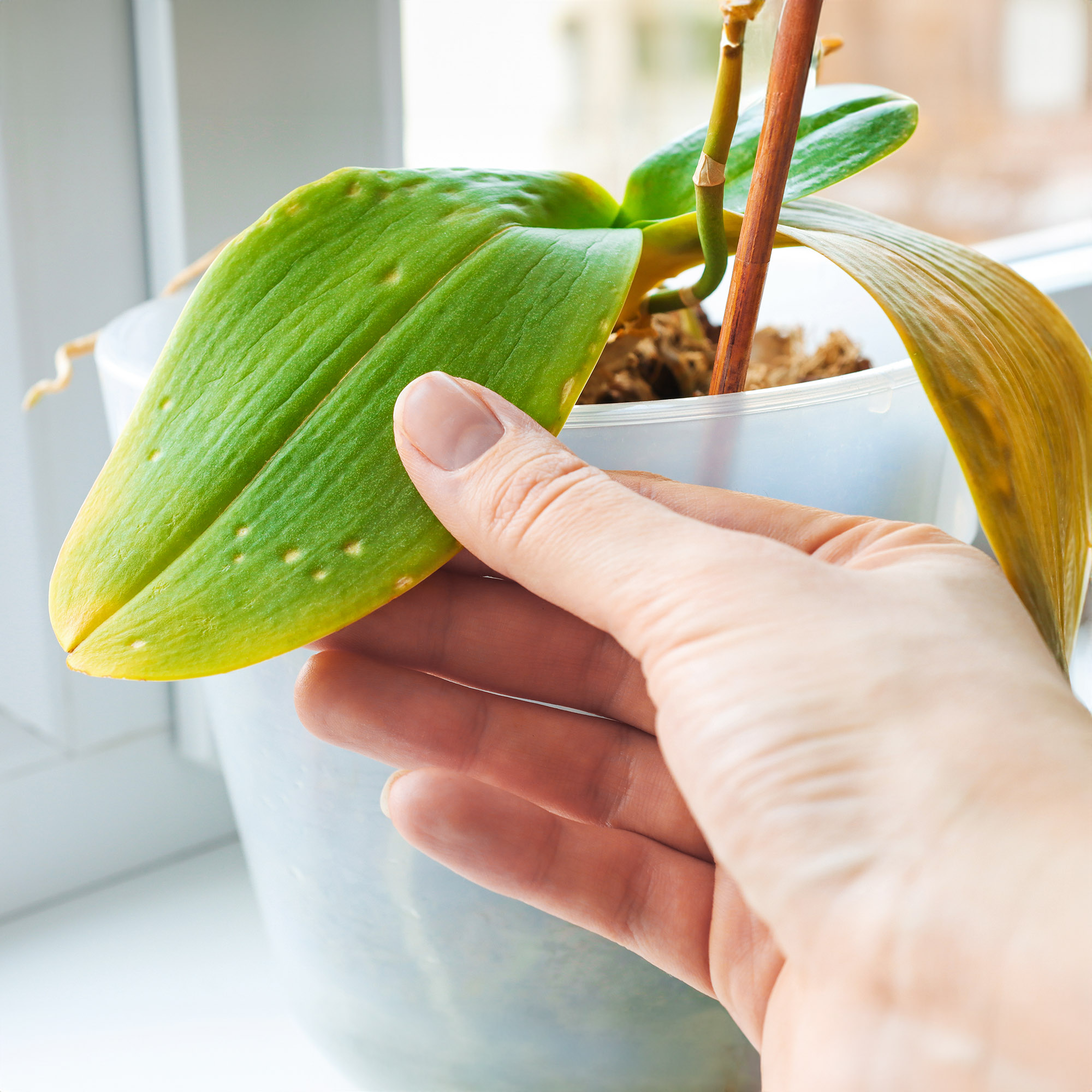 Why Is My Orchid Dying? 5 Common Causes & How To Save It Before It's Too Late
Why Is My Orchid Dying? 5 Common Causes & How To Save It Before It's Too LateStruggling to keep your orchid alive? Learn the top mistakes that cause orchids to decline – and the simple fixes to bring yours back to life.
By Bonnie L. Grant
-
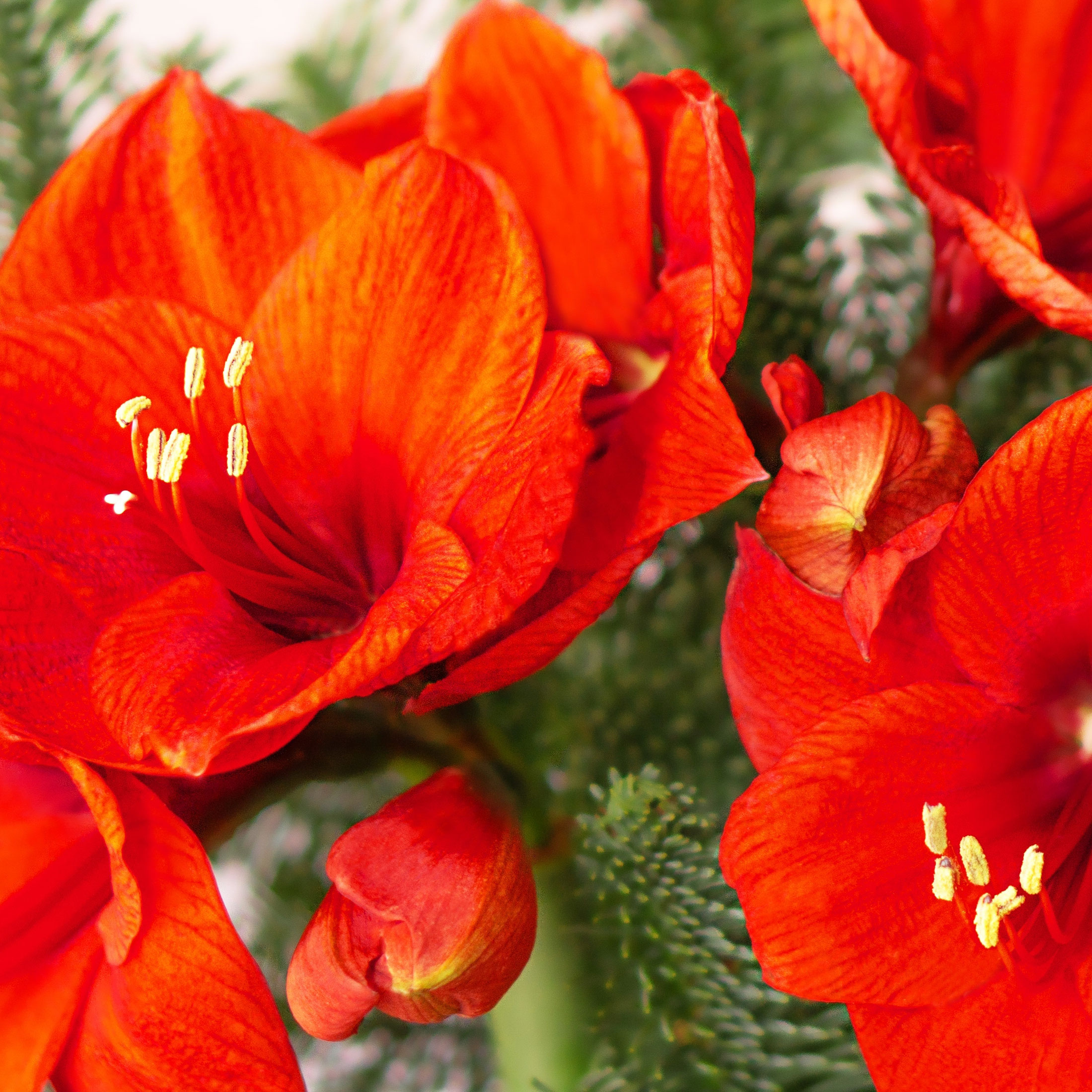 Warm Up Your Winter With Indoor Reds! 8 Red Amaryllis Varieties For Sizzling Seasonal Interest
Warm Up Your Winter With Indoor Reds! 8 Red Amaryllis Varieties For Sizzling Seasonal InterestWell loved as a bold decorative holiday bloomer, the red amaryllis is a hot favorite for winter displays. These red amaryllis varieties are guaranteed to fire up the season
By Tonya Barnett
-
 Dendrobium Nobile Orchid: How To Care For This Graceful, Easy-Going Houseplant
Dendrobium Nobile Orchid: How To Care For This Graceful, Easy-Going HouseplantLearn how to care for elegant dendrobium nobile orchids. These undemanding plants make a stunning addition to any orchid collection and are ideal for beginners.
By Bonnie L. Grant
-
 Poinsettia Pinks: 7 Pink Poinsettias To Grow For Neon Hot Tones And Cool Pretty Pastels
Poinsettia Pinks: 7 Pink Poinsettias To Grow For Neon Hot Tones And Cool Pretty PastelsWhile the traditional red poinsettia is a staple of many homes over the holiday period, they are not your only option. For cheerful brights or pastels, why not grow pink poinsettias?
By Tonya Barnett
-
 Want Amaryllis But Not Red? Try These 8 White Amaryllis Varieties For The Ultimate Elegance
Want Amaryllis But Not Red? Try These 8 White Amaryllis Varieties For The Ultimate EleganceYou’re probably familiar with the crisp red blooms of the traditional amaryllis – but if you feel like something more unusual and elegant, why not try white amaryllis?
By Mary Ellen Ellis
-
 Are Poinsettias Poisonous To Cats? What You Need To Know For Happy, Healthy Felines
Are Poinsettias Poisonous To Cats? What You Need To Know For Happy, Healthy FelinesThey have the potential to brighten up homes long after the holidays, but are poinsettias poisonous to cats? Make sure you read this before mixing the two!
By Susan Albert